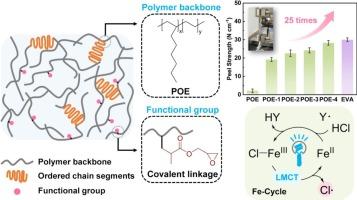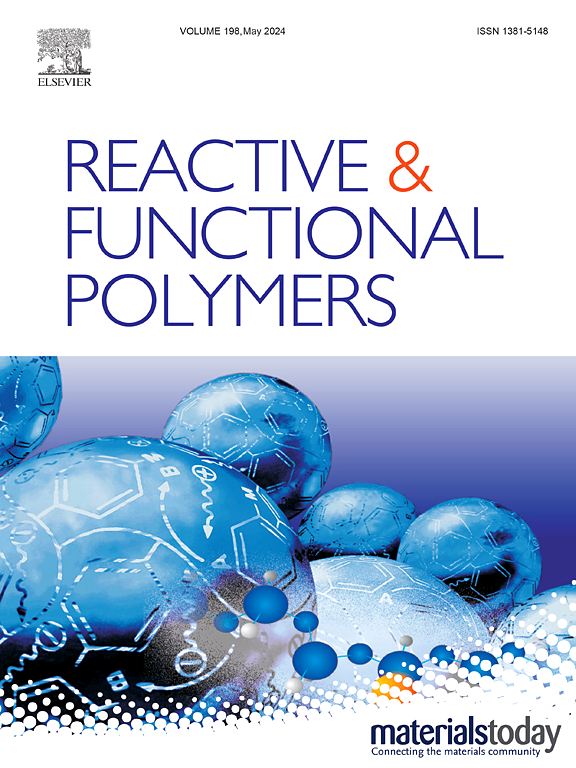Visible-light-driven Fe-catalyzed alkylation for synthesizing functionalized polyolefin elastomers as advanced encapsulants in photovoltaic modules
IF 4.5
3区 工程技术
Q1 CHEMISTRY, APPLIED
引用次数: 0
Abstract
Polyolefin elastomer (POE) has emerged as a promising encapsulant for photovoltaic modules, attributed to its exceptional water vapor barrier properties, robust weather resistance, and enhanced anti-potential induced degradation (anti-PID) capabilities. Despite these advantages, the interfacial adhesion of POE remains a significant challenge, particularly its suboptimal bonding with glass and solar cells, which impedes its broader application within the photovoltaic industry. This study introduced glycidyl methacrylate (GMA) monomers into POE through a photo-induced iron-catalyzed alkylation reaction, developing a novel polyolefin encapsulant for photovoltaic modules. The encapsulant was designed to possess high light transmittance, enhanced adhesion, and elevated resistivity. The modified POE boasts an impressive light transmittance nearing 98% and an adhesive strength of 28.3 N cm−1, both superior to traditional ethylene-vinyl acetate copolymer (EVA) materials. Additionally, this work delves into the correlation between crystallization behavior and light transmittance, elucidating the influence of GMA incorporation on the adhesion and insulation properties of POE through gaussian simulations.

利用可见光驱动的铁催化烷基化合成功能化聚烯烃弹性体,作为光伏组件的高级封装材料
聚烯烃弹性体(POE)因其优异的水蒸气阻隔性能、强大的耐候性和更强的抗电位诱导降解(anti-PID)能力,已成为一种前景广阔的光伏组件封装材料。尽管具有这些优点,但 POE 的界面粘附性仍然是一个重大挑战,尤其是它与玻璃和太阳能电池的粘结性不理想,这阻碍了它在光伏产业中的广泛应用。本研究通过光诱导铁催化的烷基化反应,将甲基丙烯酸缩水甘油酯 (GMA) 单体引入 POE,开发出一种用于光伏模块的新型聚烯烃封装剂。这种封装剂具有高透光率、更强的粘附性和更高的电阻率。改性 POE 的透光率接近 98%,粘合强度达到 28.3 N cm-1,均优于传统的乙烯-醋酸乙烯共聚物(EVA)材料。此外,这项研究还深入探讨了结晶行为与透光率之间的相关性,并通过高斯模拟阐明了加入 GMA 对 POE 的粘附性和绝缘性能的影响。
本文章由计算机程序翻译,如有差异,请以英文原文为准。
求助全文
约1分钟内获得全文
求助全文
来源期刊

Reactive & Functional Polymers
工程技术-高分子科学
CiteScore
8.90
自引率
5.90%
发文量
259
审稿时长
27 days
期刊介绍:
Reactive & Functional Polymers provides a forum to disseminate original ideas, concepts and developments in the science and technology of polymers with functional groups, which impart specific chemical reactivity or physical, chemical, structural, biological, and pharmacological functionality. The scope covers organic polymers, acting for instance as reagents, catalysts, templates, ion-exchangers, selective sorbents, chelating or antimicrobial agents, drug carriers, sensors, membranes, and hydrogels. This also includes reactive cross-linkable prepolymers and high-performance thermosetting polymers, natural or degradable polymers, conducting polymers, and porous polymers.
Original research articles must contain thorough molecular and material characterization data on synthesis of the above polymers in combination with their applications. Applications include but are not limited to catalysis, water or effluent treatment, separations and recovery, electronics and information storage, energy conversion, encapsulation, or adhesion.
 求助内容:
求助内容: 应助结果提醒方式:
应助结果提醒方式:


